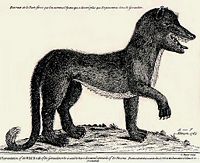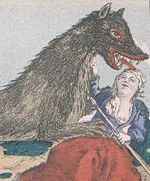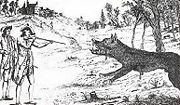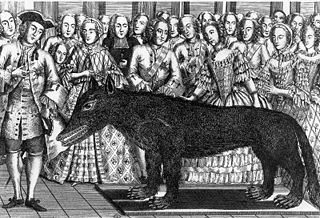Beast of Gévaudan
| Beast of Gévaudan | |
|---|---|
 |
|
| Artist's conception of one of the Beasts of Gevaudan, 18th-century engraving by A.F. of Alençon |
|
| Creature | |
| Name: | Beast of Gévaudan |
| AKA: | La bête du Gévaudan (French) Wolf of Chazes Lycopardus parthenophagus[1] |
| Classification | |
| Grouping: | Wolves or Wolf-dog crossbreds |
| Data | |
| First reported: | 1764 |
| Last sighted: | 1767 |
| Country: | France |
| Region: | Gévaudan (Modern day Lozère) |
The Beast of Gévaudan (French: La bête du Gévaudan) is a name given to man-eating wolf-like animals that terrorized the former province of Gévaudan (modern day département of Lozère), in the Margeride Mountains in south-central France from 1764 to 1767 over an area stretching 90 by 80 kilometres (56 mi × 50 mi).[2] The beasts were consistently described by eyewitnesses as having formidable teeth and immense tails. Their fur had a reddish tinge, and was said to have emitted an unbearable odor. They killed their victims by tearing at their throats with their teeth. The number of victims claimed by the beasts differ according to source, however, de Beaufort (1987) estimated a toll of 210 attacks resulting in 113 deaths and 49 injuries. Ninety-eight of the victims killed were partially eaten.[2] Author Brockis claims 25 women, 68 children, and 6 men were killed, with over 30 others injured.[3] An enormous amount of manpower and resources was used in the hunting of the animals, including the army, conscripted civilians, several nobles and a number of royal huntsmen.[2] All animals operated outside of ordinary wolf packs, though eyewitness accounts indicate that in some instances they were accompanied by a smaller female which did not take part in the attacks. The story is a popular subject for cryptozoologists and conspiracy theorists.
Contents |
Similar events
The Gévaudan attacks were not considered isolated events. A century earlier, similar killings occurred in 1693 at Benais, in which over 100 victims, almost all of them women and children, were claimed by a creature described as exactly resembling the Gévaudan Beasts. Four decades after the Gévaudan attacks, more attacks occurred between 1809 and 1813 in Vivarais, when at least 21 children and adolescents were killed by another beast. From 1875 to 1879, more attacks occurred in L'Indre. All these killings, including the Gévaudan attacks seem to have occurred mostly in four year periods. Attacks by wolf-like creatures continued to be reported in France up until 1954.[3]
History
Attacks

The first attack that provided a description of one of the creatures took place on 1 June 1764. A woman from Langogne saw a large, lupine animal emerge from the trees and charge directly toward her, but it was driven away by the farm's bulls.
On 30 June, the first official victim of the beast was Jeanne Boulet, killed near the village of Les Hubacs, not far from Langogne.
The beast also seemed to target people over farm animals, reportedly having an aversion to cattle; many times it would attack someone while cattle were in the same field.
Hunt for the beasts
Death of the first beast
On 12 January 1765, Jacques Portefaix and six friends, including two girls, were attacked by the Beast; they drove it away by staying grouped together. Their fight caught the attention of King Louis XV, who awarded 300 livres to Portefaix, and another 300 livres to be shared among the others. He also directed that Portefaix be educated at the state's expense. The King then directed professional wolf-hunters, Jean-Charles-Marc-Antoine Vaumesle d'Enneval and his son Jean-François, to kill the beast. He had taken a personal interest in the attacks. They arrived in Clermont-Ferrand on 17 February 1765, bringing with them eight bloodhounds which had been trained in wolf-hunting. They spent several months hunting wolves, believing them to be the beast. However the attacks continued, and by June 1765 they were replaced by François Antoine (also wrongly named Antoine de Beauterne), the king's harquebus bearer and Lieutenant of the Hunt. He arrived in le Malzieu on 22 June.

On 21 September 1765, Antoine killed a large gray wolf measuring 80 centimetres (31 in) high, 1.7 metres (5.6 ft) long, and weighing 60 kilograms (130 lb). The wolf was called Le Loup de Chazes, after the nearby Abbaye des Chazes. It was agreed locally that this was quite large for a wolf. Antoine officially stated: "We declare by the present report signed from our hand, we never saw a big wolf that could be compared to this one. Which is why we estimate this could be the fearsome beast that caused so much damage." The animal was further identified as the culprit by attack survivors, who recognized the scars on the creature's body, inflicted by victims defending themselves.[2]
The wolf was stuffed and sent to Versailles where Antoine was received as a hero, receiving a large sum of money as well as titles and awards.
However, on 2 December 1765, another beast emerged in la Besseyre Saint Mary, severely injuring two children. Dozens more deaths are reported to have followed.
Death of the second beast
The second beast was last sighted alive at Sarlat, a prehistoric cavernous region just outside Gevaudan, on 4 August 1767.[3] The killing of the creature that eventually marked the end of the attacks is credited to a local hunter, Jean Chastel, at the Sogne d'Auvers on 19 June 1767. Later novelists (Chevalley, 1936) introduced the idea that Chastel shot it with a silver bullet of his own manufacture.[4] Upon being opened, the animal's stomach was shown to contain human remains.[2]
Controversy surrounds Chastel's account of his success. Family tradition claimed that, when part of a large hunting party, he sat down to read the Bible and pray. During one of the prayers the creature came into sight, staring at Chastel, who finished his prayer before shooting the beast. This would have been aberrant behavior for the beast, as it would usually attack on sight. Some believe this is proof Chastel participated with the beast, or even that he had trained it. However, the story of the prayer may simply have been invented out of religious or romantic motives.
Identity of the Beasts

Various explanations were offered at the time of the attacks as to the beast's identity. They ranged from exaggerated accounts of wolf attacks, to a loup-garou (English: werewolf), all the way to the beast being a punishment from God. An anonymous 18th century author gave the Beasts the binomial name of Lycopardus parthenophagus (Panther-wolf, devourer of maidens).[1]
Suggested species
Richard H. Thompson, author of Wolf-Hunting in France in the Reign of Louis XV: The Beast of the Gévaudan, contended that there can be satisfactory explanations based on large wolves for all the Beast's depredations.[5] Though wolves in the wild usually avoid contact with humans, they will attack livestock when their natural prey runs out. Conversely, the beasts themselves were said to have preferentially taken human victims, ignoring the livestock present in the area. Some experts, however, state that wolves at the time may have been more aggressive than their modern-day counterparts, saying that today's generation of shy wolves is the result of natural selection favoring animals which were less prone to attacking humans with firearms. In areas of the modern world where wolf attacks are still a regular occurrence, the afflicted communities are usually poverty-stricken with a general lack of predator control technology[6], mirroring the situation of the Gévaudanais of the 18th century. A Fennoscandian study on wolf attacks occurring in the 18th–19th centuries indicated that until the 20th century, wolf predation on humans was an occasional, but widespread feature of life in Europe. The study further showed that similarly to the Beast of Gévaudan, victims of wolf attacks were almost entirely children, and in the few cases when an adult was killed, it was almost always a woman.[7] Like wolves,[2] the beast killed its human victims by attacking the facial regions.[1]
Another explanation is that the beasts were some type of domestic dog or crosses between wild wolves and domestic dogs, on account of their large size and unusual coloration.[2] This theory has found support from naturalist Michel Louis, author of the book La bête du Gévaudan: L'innocence des loups (English: The Beast of Gévaudan: The innocence of wolves) and an episode of Animal X. Wolf-dog crossbreds were usually noted as not sharing their wolf parent's fear of man. In many cases the resulting adult crossbred may be larger than either of its parents due to the genetic phenomenon of heterosis.[8] Observations on wild wolf-dog crossbreds in the former Soviet Union indicate that they may form larger packs than pure wolves, and have greater endurance when chasing prey.[9]
In the arts and popular culture
Literature
Robert Louis Stevenson traveled through the region in 1878 and described the incident in his book Travels with a Donkey in the Cévennes, in which he claims that that at least one of the creatures was a wolf:
For this was the land of the ever-memorable Beast, the Napoleon Bonaparte of wolves. What a career was his! He lived ten months at free quarters in Gévaudan and Vivarais; he ate women and children and ‘shepherdesses celebrated for their beauty’; he pursued armed horsemen; he has been seen at broad noonday chasing a post-chaise and outrider along the king’s high-road, and chaise and outrider fleeing before him at the gallop. He was placarded like a political offender, and ten thousand francs were offered for his head. And yet, when he was shot and sent to Versailles, behold! a common wolf, and even small for that.
Film
The attacks spawned two recent film adaptations; Brotherhood of the Wolf (2001) directed by Christophe Gans and La bête du Gévaudan (2003) by Patrick Volson.
Brotherhood of the Wolf, while based on the records of the creature, also took several creative liberties in order to make the story more entertaining. Rather than a wolf or wolf-dog crossbred, the movie portrays the creature as a lioness equipped with armor to make it seem more threatening. The Beast is the instrument of the film's titular secret organization, which attempts to undermine public confidence in the king and ultimately take over the country by stating that the Beast is a divine punishment for the King's indulgence of the modern embrace of science over religion.
Gallery
See also
- Wolf of Soissons
- Wolves of Périgord
- Wolf of Sarlat
- Wolves of Paris
- Wolf of Ansbach
- Wolf attacks on humans
- Wolf hunting
References
- ↑ 1.0 1.1 1.2 Woodward, Ian (1979). The Werewolf Delusion. pp. p 256. ISBN 0448231700.
- ↑ 2.0 2.1 2.2 2.3 2.4 2.5 2.6 "The Fear of Wolves: A Review of Wolf Attacks on Humans" (PDF). Norsk Institutt for Naturforskning. Retrieved on 2008-06-26.
- ↑ 3.0 3.1 3.2 Brockis, David (2006). The Beast of Gevaudan: La Bête du Gévaudan. ISBN 1420872486. http://labete.7hunters.net/.
- ↑ Robert Jackson (1995) Witchcraft and the Occult. Devizes, Quintet Publishing: 25
- ↑ Thompson, Richard H. (1991). Wolf-Hunting in France in the Reign of Louis XV: The Beast of the Gévaudan. pp. pp.367. ISBN 0889467463.
- ↑ "Wolf Attacks on Humans". T. R. Mader. Retrieved on 2007-05-31.
- ↑ "Is the fear of wolves justified? A Fennoscandian perspective." (PDF). Acta Zoologica Lituanica, 2003, Volumen 13, Numerus 1. Retrieved on 2008-05-09.
- ↑ "The Wolf-Dog Hybrid: An Overview of a Controversial Animal". Animal Welfare Information Center Newsletter (2000). Retrieved on 2008-05-17.
- ↑ Graves, Will (2007). Wolves in Russia: Anxiety throughout the ages. pp. pp.222. ISBN 1550593323.
External links
- La Bête du Gévaudan Website
- In the Shadow of the Beast Website Includes a compendium of all publicly available historical documents about the Beast (in the original French)
|
|||||||||||||||||||||||||||||||||||||||||||||||||||